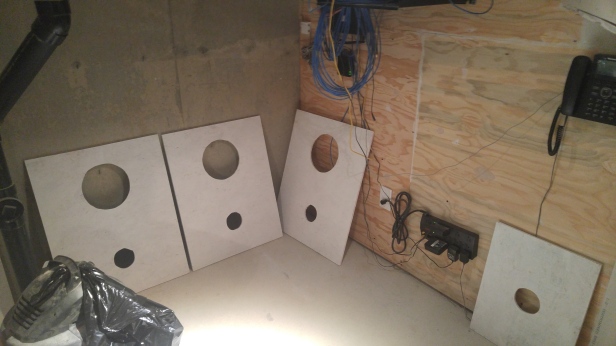To begin many thanks goes out to my friend Tony who helped pick up all the drywall I needed and also helped lug it all into my basement. Another thanks has to go out to my father-in-law Wayne who began helping at this stage. Drywall certainly goes up much easier and faster with two people. So you may be wondering how much drywall I needed. I picked up 20 sheets and I used it all. I’m finding that there’s a lot of wastage since the ceiling is only 6.5′ tall and I don’t want to piece things together as my mudding skills will already be put to the test.
However, I did use pieces for the first layer of drywall since you won’t even see this layer. That’s right… I’m layering the drywall. Dual-layered drywall has been used for quite some time to aid in sound isolation so I figured I’d take advantage of this as well. To read more about my sound isolation methods be sure to take a look at my post here Shhh… Quiet. [Sound Isolation].

With all the surface area of the duct work and the double layered drywall, plus the ceiling, I’ve used up all of the drywall. Any scraps will be used in the family room when I develop that. In the meantime, I tried to make sure the frame work around the ducts was as minimal as possible since I didn’t want to lose any space I didn’t have to. This proved a little difficult as I haven’t done anything like this before. Either way everything is finally drywalled and I’m a happy camper. At the end, I ran out of drywall, but that was okay. I only needed to cover the lowered ceiling so I used the sheet of OSB I bought to protect the drywall on the ride home. This way it’s much easier to remove if I need access to the duct work etc.

In addition to this OSB I also used smaller pieces as panels that were cut to approx 24″ x 30″ except two that were smaller. These panels have two purposes: 1) they’re strong enough to hold the weight of mounted equipment such as my recessed lights and speakers, 2) access to the electrical junction boxes, since I’m not allowed to permanently cover them. And actually there is also the reason of possibly running wires later if needed.

Next up is mudding and taping… But maybe I’ll skip this or make a quick blog about it. I’m not a good example to follow here, even though I think I can mud okay, it’s probably not professional quality lol. So that’s it for now, I’ll be back soon with some more interesting stuff.
Drywall. Things are shaping up! (with a little OSB here and there)
